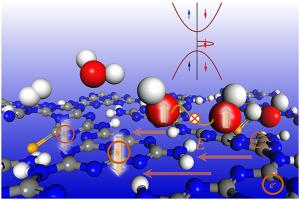Nano Energy ( IF 16.8 ) Pub Date : 2021-01-18 , DOI: 10.1016/j.nanoen.2021.105783 Yong Wang , Wei Xu , Yu Zhang , Yizhang Wu , Zhaokun Wang , Lin Fu , Fulan Bai , Boye Zhou , Tingting Wang , Liang Cheng , Jianzhang Shi , Hong Liu , Rusen Yang

|
Atomically thin 2D carbon nitride sheets (CNs) became one of the most promising solar energy conversion materials. However, the application of CNs is still limited due to two reasons: (i) the bandgap of CNs is wider than its counterpart due to the quantum size effect, which reduces its effective utilization of the entire solar spectrum, and (ii) the visible-light photocatalytic activity of CNs is still low due to its faster recombination of photogenerated carriers than photocatalytic reaction. Here, we achieve a strong visible-light absorption band in CNs through fluorination followed by thermal defluorination in Se vapor (Se-CNs). Experimental results and theoretical calculations confirm that the formation of cyano groups accompanied with in-situ Se doping expands the absorption edge of CNs from 416 to 584 nm. More importantly, a downward electron spin polarization in the CNs structure improves dramatically the efficiency of charge separation and surface catalysis reaction. The hydrogen generation rate of Se-CNs with 3 wt% Pt under visible-light irradiation (> 420 nm) reaches up to 5411.2 μmol h−1 g−1 that is 176.5 times of the hydrogen generation of CNs. Additionally, the visible-light photocatalytic oxygen evolution of Se-CNs acquires tremendous improvements. This work provides a new approach for improving electron structure of atomically thin 2D non-metal semiconductor materials.
中文翻译:

将自旋极化引入原子薄的2D氮化碳片中,以大大扩展可见光光催化水分解
原子薄的2D氮化碳薄板(CN)成为最有前途的太阳能转换材料之一。但是,由于两个原因,氯化萘的应用仍然受到限制:(i)由于量子尺寸效应,氯化萘的带隙宽于其对应带隙,这降低了其对整个太阳光谱的有效利用;以及(ii)可见光由于CNs的光生载流子重组比光催化反应快,因此CNs的轻光催化活性仍然很低。在这里,我们通过氟化,然后在硒蒸气(Se-CNs)中进行热脱氟化作用,在氯化萘中获得了很强的可见光吸收带。实验结果和理论计算证实,氰基的形成伴随原位硒掺杂将CNs的吸收边从416 nm扩展到584 nm。更重要的是,CNs结构中的向下电子自旋极化极大地提高了电荷分离和表面催化反应的效率。Pt 3 wt%的Se-CNs在可见光(> 420 nm)下的氢生成速率高达5411.2μmolh-1 g -1,是CNs氢生成的176.5倍。另外,Se-CNs的可见光光催化氧释放得到了极大的改善。这项工作为改善原子薄的2D非金属半导体材料的电子结构提供了一种新方法。











































 京公网安备 11010802027423号
京公网安备 11010802027423号